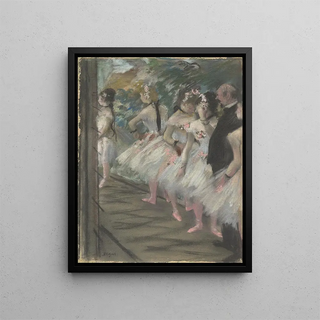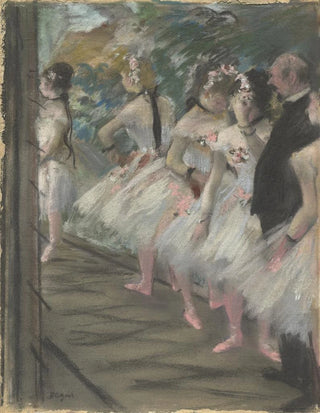Art print | The Ballet - Edgar Degas


View from behind

Frame (optional)
In the fascinating universe of art, some works transcend time and space, captivating the mind and emotions of viewers. "The Ballet" by Edgar Degas is one of those creations that, through its beauty and complexity, immerses us in the intimacy of a unique artistic representation. This iconic painting, illustrating the painter's passion for ballet and dance, invites us to discover the magic behind the scenes of a world where grace and movement intertwine. The delicacy of the ballerinas, their elegant poses, and the hushed atmosphere of the theater make this piece a true masterpiece that continues to inspire and fascinate.
Style and uniqueness of the work
Edgar Degas's style is distinguished by his innovative approach to composition and color. In "The Ballet," he captures not only the movement of the dancers but also the very essence of their art. The nuances of light and shadow, the pastel touches, and the flowing lines create a sense of dynamism and lightness. Degas, a master of movement, manages to freeze the moment while revealing the energy of the action. The ballerinas, often painted in natural and spontaneous poses, seem to flourish under the viewer's gaze, making every detail lively. The depth of field, as well as the daring angles of view, testify to a constant search for new perspectives, making this work a perfect example of Impressionism revisited by an artist who did not merely reproduce reality but sought to express its emotion.
The artist and his influence
Edgar Degas, a major figure of the Impressionist movement, knew how to blend tradition and modernity, influencing many artists over the decades. Born in 1834 in Paris, he initially turned to drawing before dedicating himself to painting, exploring various themes such as dance, cabaret, and urban life. His fascination with ballet stems from his desire to explore movement and the human form, a quest that led him to experiment with various techniques, ranging from painting to sculpture. Degas was also a pioneer in

Matte finish

View from behind

Frame (optional)
In the fascinating universe of art, some works transcend time and space, captivating the mind and emotions of viewers. "The Ballet" by Edgar Degas is one of those creations that, through its beauty and complexity, immerses us in the intimacy of a unique artistic representation. This iconic painting, illustrating the painter's passion for ballet and dance, invites us to discover the magic behind the scenes of a world where grace and movement intertwine. The delicacy of the ballerinas, their elegant poses, and the hushed atmosphere of the theater make this piece a true masterpiece that continues to inspire and fascinate.
Style and uniqueness of the work
Edgar Degas's style is distinguished by his innovative approach to composition and color. In "The Ballet," he captures not only the movement of the dancers but also the very essence of their art. The nuances of light and shadow, the pastel touches, and the flowing lines create a sense of dynamism and lightness. Degas, a master of movement, manages to freeze the moment while revealing the energy of the action. The ballerinas, often painted in natural and spontaneous poses, seem to flourish under the viewer's gaze, making every detail lively. The depth of field, as well as the daring angles of view, testify to a constant search for new perspectives, making this work a perfect example of Impressionism revisited by an artist who did not merely reproduce reality but sought to express its emotion.
The artist and his influence
Edgar Degas, a major figure of the Impressionist movement, knew how to blend tradition and modernity, influencing many artists over the decades. Born in 1834 in Paris, he initially turned to drawing before dedicating himself to painting, exploring various themes such as dance, cabaret, and urban life. His fascination with ballet stems from his desire to explore movement and the human form, a quest that led him to experiment with various techniques, ranging from painting to sculpture. Degas was also a pioneer in






